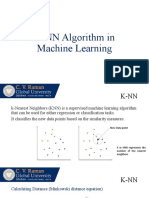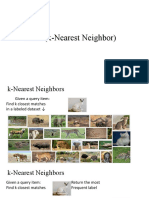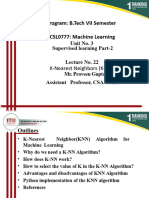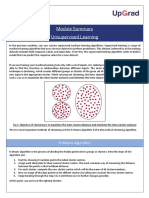0% found this document useful (0 votes)
13 views22 pagesNew Data Science Module Nearest Neighbors
The document provides an overview of the k-Nearest Neighbors (kNN) classification method, explaining its general concept of classifying points based on the majority class of their neighbors. It includes examples of how to assign labels to data points, the importance of choosing an appropriate value for k, and the necessity of scaling features for accurate distance calculations. Additionally, it demonstrates the implementation of kNN in Python using the scikit-learn library with practical examples and visualizations.
Uploaded by
akul joshiCopyright
© © All Rights Reserved
We take content rights seriously. If you suspect this is your content, claim it here.
Available Formats
Download as PDF, TXT or read online on Scribd
0% found this document useful (0 votes)
13 views22 pagesNew Data Science Module Nearest Neighbors
The document provides an overview of the k-Nearest Neighbors (kNN) classification method, explaining its general concept of classifying points based on the majority class of their neighbors. It includes examples of how to assign labels to data points, the importance of choosing an appropriate value for k, and the necessity of scaling features for accurate distance calculations. Additionally, it demonstrates the implementation of kNN in Python using the scikit-learn library with practical examples and visualizations.
Uploaded by
akul joshiCopyright
© © All Rights Reserved
We take content rights seriously. If you suspect this is your content, claim it here.
Available Formats
Download as PDF, TXT or read online on Scribd
/ 22
























































































